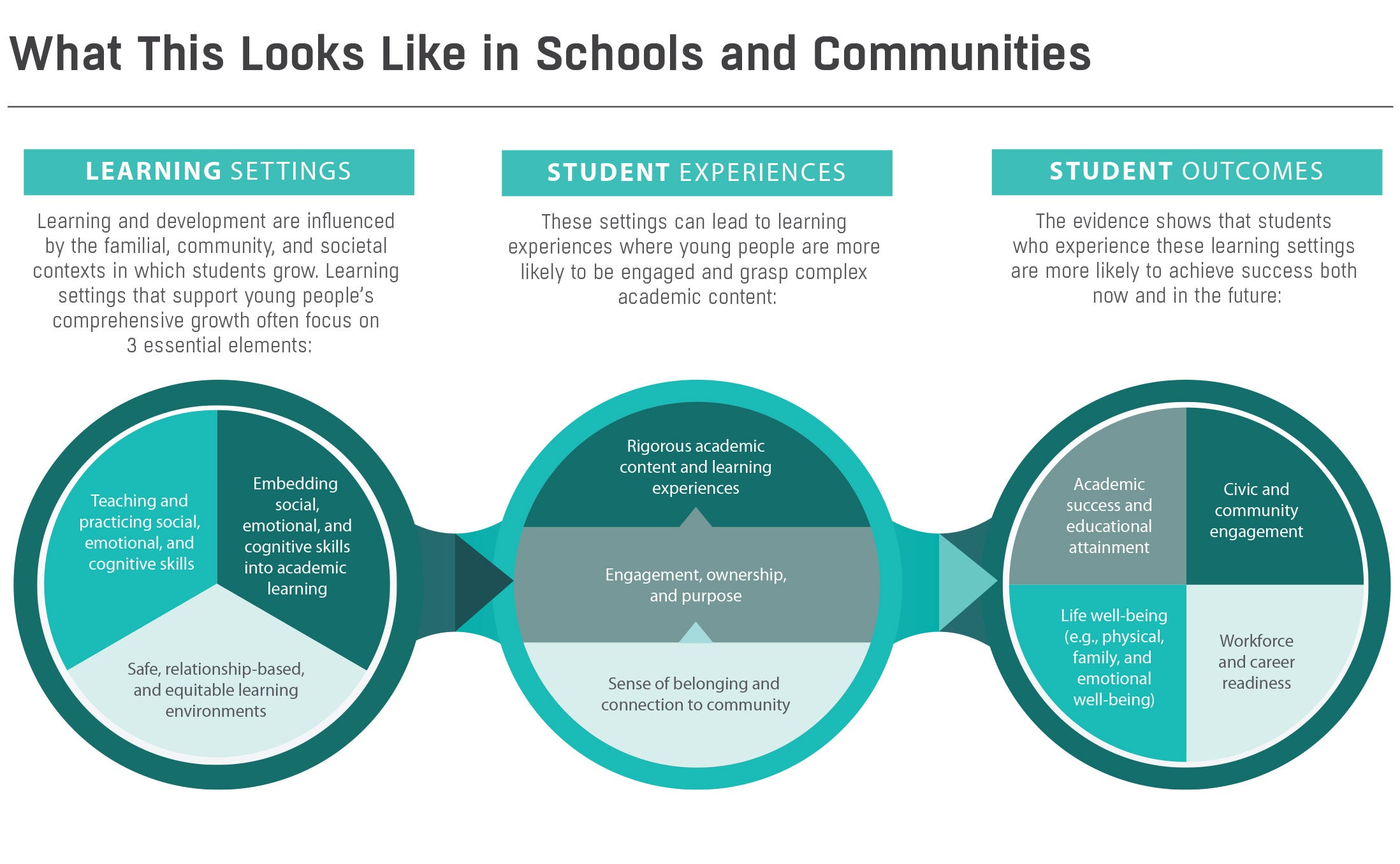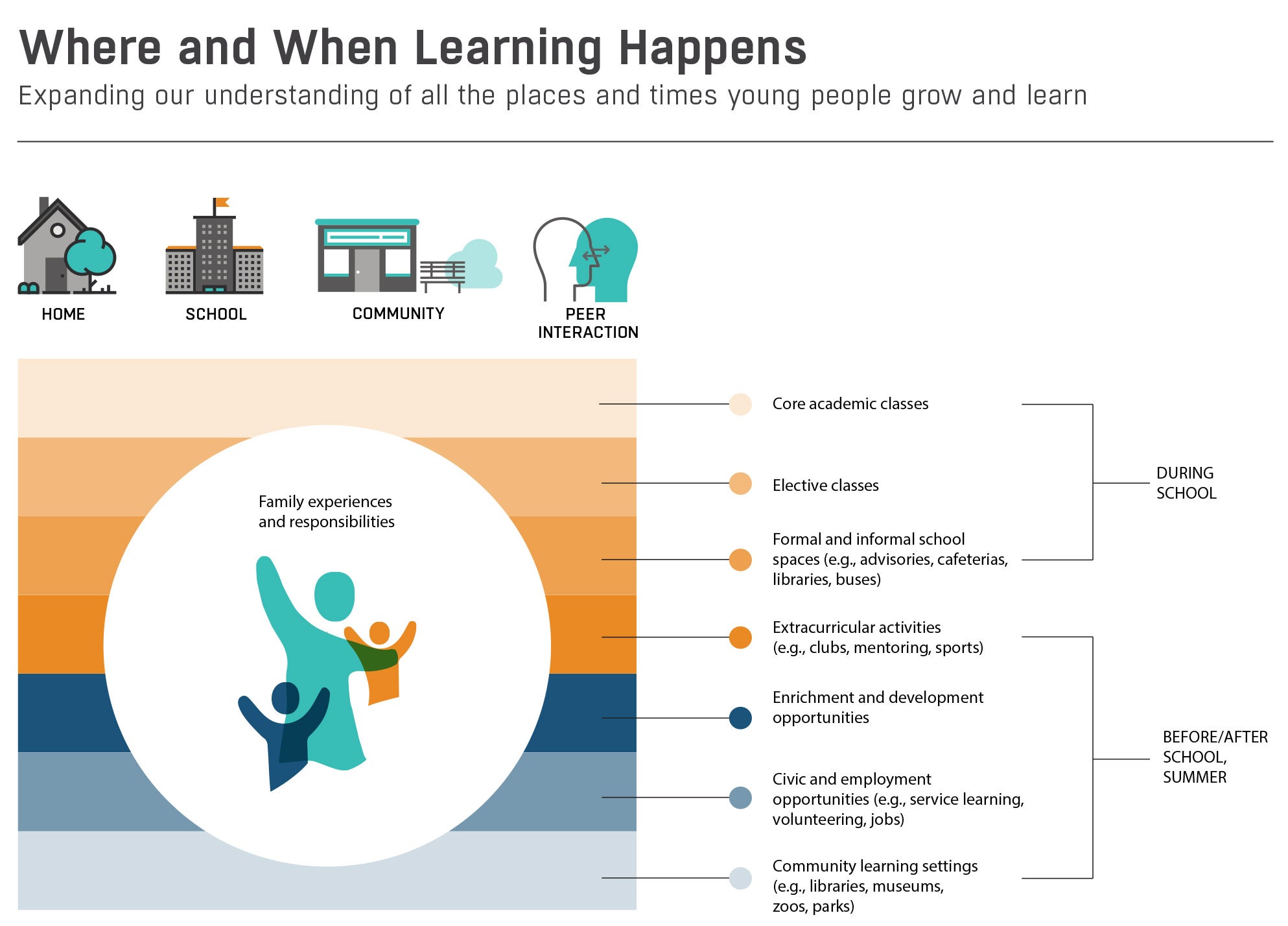“I don’t see this as an initiative – I see this as the way we do schools.”
That comment by LaTanya McDade, chief education officer in Chicago Public Schools, captured the spirit at the launch in Washington, D.C., of a new report: From A Nation at Risk to a Nation at Hope: Recommendations from the National Commission on Social, Emotional, and Academic Development.
The Wallace Foundation was one of a group of foundations funding the commission’s work, which has unfolded over the past two years or so, and was one of more than 100 signatories to its recommendations.
Although they have no direct authority, national commissions can play important roles in promoting dialogue and defining issues. In 1983, the landmark report A Nation at Risk was credited with sparking the standards-based accountability movement. In a nod to that report, the new report’s title, coined by Washington Post columnist Michael Gerson, referenced the power of that earlier report as an agenda-setting device–but with the twist that its findings give us new hope for progress.
If A Nation at Risk focused on a particular kind of accountability, A Nation at Hope urges a broader focus on tapping the combined forces of academic learning and social and emotional learning: “After two decades of education debates that produced deep passions and deeper divisions, we have a chance for a fresh start. A growing movement dedicated to the social, emotional and academic well-being of children is reshaping learning and changing lives across America. On the strength of its remarkable consensus, a nation at risk is finally a nation at hope.”

At the heart of the report is a finding that “Social, emotional, cognitive, linguistic and academic development are deeply intertwined in the brain and in behavior and together influence school and life outcomes, including higher education, physical and mental health, economic well-being, and civic engagement.” This means that providing more opportunities for acquiring social and emotional skills has the chance to improve both academic outcomes, and the ability to compete in the labor market, the report concludes.
An implication, said Mary Helen Immordino-Yang, a professor at the USC Rossier School of Education, is that educators focus both on transferring knowledge to students, and seeking to understand them and create a climate where learning can flourish. In addition to recognizing that we need to “enable children to relate well to other people and manage emotions,” we need to recognize that “the process of building knowledge can often be connected to emotions.”
Rooted on the finding that academic learning and social and emotional learning are “intertwined,” the report makes key six recommendations:
- Set a vision for student success that prioritizes the whole child.
- Transform learning settings so they are physically and emotionally safe and foster strong bonds among students and adults.
- Change instruction to teach students social, emotional and cognitive skills; embed these skills in academics and schoolwide practices.
- Build adult expertise in child and adolescent development.
- Align resources and leverage partnerships across schools, families and communities to address the whole child.
- Forge closer connections between research and practice to generate useful, actionable information for educators.

The livestreamed launch saw a broad range of support for the commission’s work.
Josh Bolten, president and CEO of the Business Roundtable representing the nation’s 200 largest corporations employing 17 million people, said that over the past two years, concerns have grown among his members that while “they can find people, they can’t find people who are prepared technically and with the soft skills they need to enter the workforce.” In 2017, he noted, when asked about the greatest headwinds they face, for the first time concerns about the labor force nudged out regulation; by 2018, labor was the lead concern by a two-to-one margin. Businesses, he said, are already engaged in some way “to try to make sure that the education system is preparing graduates to do the jobs they have.”
From the policy community, Gov. Mitch Daniels applauded the notion that SEL was a “missing ingredient” in educational attainment, saying “this report is timely, necessary and the gap is not going to be filled by the environments that the children go home to after schools.” He also urged inclusion of social and emotional learning in the curricula of the nation’s 1,300 colleges of education, one of the recommendations in the report.
Former Delaware Governor Jack Markell offered that “movements will spread when there are narratives of people doing this right,” and suggested that parent-teacher associations and others could share stories of success that can be emulated and adapted locally rather than in a “top-down” manner.
Marc Morial, CEO of the National Urban League, said a focus on social and emotional learning was a strong fit with the League’s emphasis on excellence and equity. “There is something commonsensical about this. For us to raise the next generation, we have to imbue them with a range of skills. Now we have to be much more intentional about it because of changes in family structure, diversity and globalization.”
He, like others, urged that community-based organizations providing afterschool be part of the solution. “It’s going to take a symphony, it’s going to take an orchestra, I want to make sure afterschool providers are in the band and not in the stands.”
That was a theme also shared by Josh Garcia, deputy superintendent in Tacoma Public Schools, a Wallace grantee, who emphasized the importance of having multiple partners and not just one. He described an “accordion strategy” used over the past decade to shape the Tacoma Whole Child Initiative that comprised four shifts: schools, parents, afterschool providers and partnerships between all three. By accordion, he meant devising plans, listening to the community for ideas and input, and then closing the accordion to revise the plan–then repeating the process. Garcia credited the plan for helping boost high school graduation ratesfrom 55 percent in 2010 to 89 percent in 2018, along with significant decreases in absenteeism, and tardiness and expulsions.
LaTanya McDade of Chicago Public Schools emphasized the value of partnerships with research organizations, noting the Chicago schools partnership with the University of Chicago Consortium on School Research, and emphasizing the value of public-facing reports that both mark progress and hold the district and its partners accountable. “When you expose the data in a meaningful way, then you are dealing with a common set of facts, and that builds understanding in the community that this work really matters.”
An example of research that affected practice was a study by the Consortium highlighting differential disciplinary patterns across schools. Fixing that involved changing adult practice, she noted. For example, Sabrina Anderson, a principal in Chicago Public Schools, described how they now begin each morning with a chance for students to share anythingthat would stop them from learning. When conflicts do arise, students in a dispute go to the “peace center” in the classroom, turn over a water bottle filled with glitter and watch the glitter fall to the bottom–reminding them to take the time to listen and talk through their differences.
Panelists, as well as Tim Shriver, co-chair of the commission, urged organizations and individuals to act on the recommendations.
“The question before is all of us is can we mount the energy on the implementation and execution side and can we hold together this cross section which includes teachers, and business and community providers to push sensible change,” said Morial of the National Urban League. “What’s exciting about this is this is the next generation of education reform with excellence and equity as its guiding principle.”
And Becky Pringle, vice president of the National Education Association, returned to the theme that in outlining a consensus, the report created the ground for action at the local and state levels: “I am energized that we are putting students at the core of this work. The report is so comprehensive and so well structured. Thank you. We have the research, we have the evidence…This is power, and together we will be worthy of our students.”
Wallace’s own work focuses on learning more about the intersection of schools and out-of-school time organizations in providing opportunities for students to acquire social and emotional skills. You can read about what we’ve already learned about social and emotional learning.




